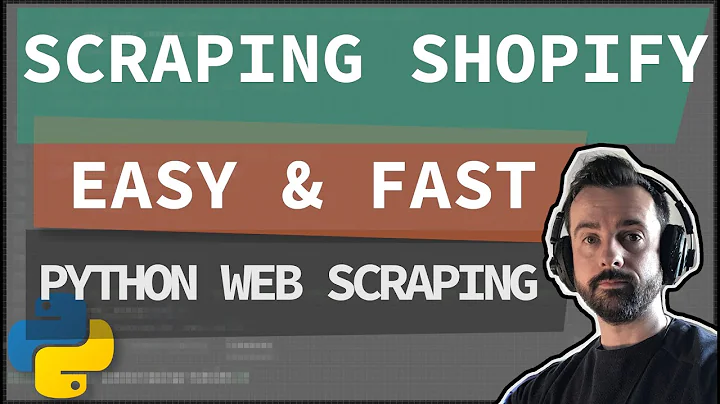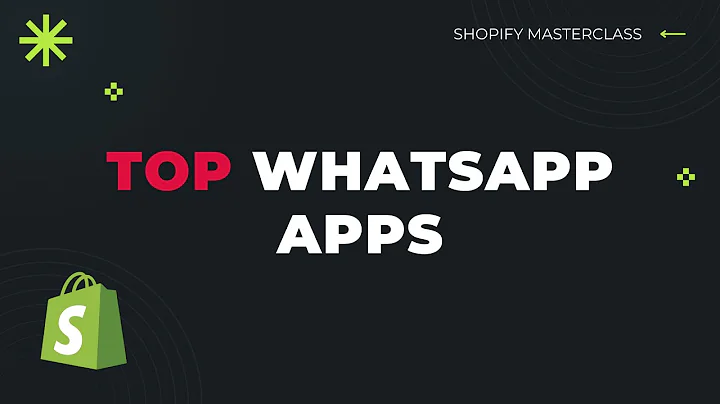Master Facebook Ads for Shopify!
Table of Contents:
- Introduction
- Setting Up Your Facebook Ads for Your Shopify Store
2.1 Connecting Shopify Store to Facebook
2.2 Confirming Events in Events Manager
2.3 Recommended Structure for an E-commerce Store
- Connecting Your Facebook Account and Business Manager
3.1 Verifying Your Domain
3.2 Connecting Your Facebook Page
3.3 Choosing Data Sharing Options
- Creating a Facebook and Instagram Shop
4.1 Configuring Web Events in Events Manager
4.2 Adding Events and Prioritizing
4.3 Standard Events vs Custom Conversions
- Choosing a Conversion Event for Optimization
5.1 Considerations for Conversion Events
5.2 Selecting the Conversion Event in Ads Manager
- Setting Up Budget and Targeting for Prospecting Campaign
6.1 Determining Budget Allocation for Prospecting and Retargeting
6.2 Creating Custom Audiences for Exclusion
6.3 Selecting Locations, Age, and Gender
6.4 Choosing Interests and Behaviors
- Ad Structure and Creative Recommendations for Prospecting
7.1 Using Videos for Prospecting Campaigns
7.2 Utilizing User-Generated Content (UGC)
7.3 Recommended Call-to-Action and Tracking Options
- Setting Up Retargeting Campaign
8.1 Duplicating Prospecting Campaign for Retargeting
8.2 Creating Custom Audiences for Retargeting
8.3 Ad Recommendations for Retargeting
- Optimizing Budget and Monitoring Frequency
9.1 Adjusting Budget Allocation Based on Frequency
- Conclusion
How to Set Up Your Facebook Ads for Your Shopify Store
Facebook is a powerful platform for promoting your Shopify store and reaching your target audience. In this article, we will guide you through the process of setting up effective Facebook ads for your e-commerce business. We will cover everything from connecting your Shopify store to Facebook, setting up events in Events Manager, choosing a conversion event, creating custom audiences, and optimizing your budget. By following these steps, you will be able to leverage the full potential of Facebook ads and boost your sales.
-
Introduction
- Importance of Facebook ads for Shopify store owners
- Benefits of integrating Shopify and Facebook
-
Setting Up Your Facebook Ads for Your Shopify Store
2.1 Connecting Shopify Store to Facebook
- Accessing the Facebook channel in Shopify
- Downloading and adding the Facebook app
2.2 Confirming Events in Events Manager
- Verifying proper event tracking in Events Manager
- Troubleshooting event tracking issues
2.3 Recommended Structure for an E-commerce Store
- Understanding the ideal campaign structure for e-commerce
- Prospecting and retargeting strategies
-
Connecting Your Facebook Account and Business Manager
3.1 Verifying Your Domain
- Importance of domain verification
- Steps to verify your domain in Facebook Business Manager
3.2 Connecting Your Facebook Page
- Linking your Facebook page to your Shopify store
- Benefits of linking your Facebook page
3.3 Choosing Data Sharing Options
- Understanding data sharing options in Facebook Business Manager
- Selecting the appropriate level of data sharing for your business
-
Creating a Facebook and Instagram Shop
4.1 Configuring Web Events in Events Manager
- Accessing event measurement settings in Events Manager
- Configuring web events for optimized tracking
4.2 Adding Events and Prioritizing
- Selecting and adding events to your tracking setup
- Prioritizing events for accurate reporting
4.3 Standard Events vs Custom Conversions
- Choosing between standard events and custom conversions
- Benefits and limitations of each tracking method
-
Choosing a Conversion Event for Optimization
5.1 Considerations for Conversion Events
- Factors to consider when selecting a conversion event
- Analyzing the customer journey and desired actions
5.2 Selecting the Conversion Event in Ads Manager
- Setting up the preferred conversion event in Ads Manager
- Configuring the conversion event to maximize campaign performance
-
Setting Up Budget and Targeting for Prospecting Campaign
6.1 Determining Budget Allocation for Prospecting and Retargeting
- Calculating the ideal budget allocation for prospecting and retargeting campaigns
- Understanding the importance of proper budget distribution
6.2 Creating Custom Audiences for Exclusion
- Identifying and excluding existing customers from prospecting campaigns
- Utilizing custom audiences for improved targeting
6.3 Selecting Locations, Age, and Gender
- Defining the target audience based on geographical location, age, and gender
- Optimization strategies for demographic targeting
6.4 Choosing Interests and Behaviors
- Selecting relevant interests and behaviors for effective prospecting campaigns
- Grouping interests for better audience segmentation
-
Ad Structure and Creative Recommendations for Prospecting
7.1 Using Videos for Prospecting Campaigns
- Exploring the effectiveness of video ads in prospecting campaigns
- Tips for creating engaging and informative video content
7.2 Utilizing User-Generated Content (UGC)
- Harnessing the power of user-generated content for increased conversions
- Encouraging customers to share their experiences through testimonials
7.3 Recommended Call-to-Action and Tracking Options
- Choosing appropriate call-to-action buttons for prospecting ads
- Configuring tracking options for accurate measurement of ad performance
-
Setting Up Retargeting Campaign
8.1 Duplicating Prospecting Campaign for Retargeting
- Understanding the benefits of duplicating prospecting campaigns for retargeting
- Streamlining the setup process by leveraging existing campaign settings
8.2 Creating Custom Audiences for Retargeting
- Identifying and creating custom audiences for retargeting campaigns
- Leveraging customer data to maximize retargeting effectiveness
8.3 Ad Recommendations for Retargeting
- Tailoring ad content and creatives for retargeting campaigns
- Strategies for re-engaging and converting warm leads
-
Optimizing Budget and Monitoring Frequency
9.1 Adjusting Budget Allocation Based on Frequency
- Importance of monitoring frequency in retargeting campaigns
- Optimizing budget distribution based on ad frequency
-
Conclusion
- Recap of the key steps in setting up Facebook ads for Shopify stores
- Final thoughts and recommendations for successful Facebook advertising
Highlights:
- Effective strategies for setting up Facebook ads for your Shopify store
- Step-by-step guide to connecting your Shopify store to Facebook and Events Manager
- Importance of domain verification and selecting the right data sharing options
- Recommendations for structuring your Facebook ads campaigns for e-commerce
- Creating custom audiences for exclusion and retargeting
- Tips for optimizing budget allocation and monitoring ad frequency
- Best practices for creating engaging and effective ad creatives
- Key considerations for choosing the right conversion event for optimization
- Maximizing the effectiveness of Facebook and Instagram shops for your e-commerce business
FAQ:
Q: Why is it important to connect my Shopify store to Facebook?
A: Connecting your Shopify store to Facebook allows you to track important events, such as purchases and add-to-cart actions, and leverage the full power of Facebook ads for promoting your products.
Q: Can I optimize my Facebook ads for events other than purchases?
A: Yes, you can choose a variety of conversion events to optimize your ads, depending on your specific goals. However, starting with the purchase event is generally recommended for e-commerce stores.
Q: How should I allocate my budget between prospecting and retargeting campaigns?
A: It is generally recommended to allocate around 70% of your budget towards prospecting campaigns and the remaining 30% towards retargeting campaigns. However, the budget allocation can vary based on your specific business needs and goals.
Q: How can I optimize my Facebook ads for better results?
A: To optimize your Facebook ads, regularly monitor ad performance, adjust budget allocation based on frequency, experiment with different ad creatives and targeting options, and analyze customer behavior to improve conversion rates.
Q: What are some recommended ad formats for prospecting campaigns?
A: Video ads and user-generated content (UGC) perform well in prospecting campaigns as they can effectively convey product information, engage the audience, and build trust. Additionally, using dynamic creatives and carousel ads can also be effective in capturing attention and showcasing multiple products.
Q: How do I create custom audiences for exclusion and retargeting?
A: You can create custom audiences in Facebook's Audience Manager by importing customer data or leveraging website traffic and engagement data. These custom audiences can be used for excluding existing customers from prospecting campaigns and retargeting specific warm leads.
Q: How do I track the performance of my Facebook ads?
A: Facebook Pixel is a powerful tool for tracking and measuring the performance of your ads. By properly configuring your pixel and events in Events Manager, you can gain valuable insights into how your ads are driving conversions, and make data-driven optimizations to improve results.
Q: How does the iOS 14 update impact Facebook advertising?
A: The iOS 14 update introduced new privacy measures that affect how Facebook can track and measure events. It is essential to ensure your domain is verified and implement proper event tracking configurations to mitigate the impact of these changes and maintain effective ad performance.






















